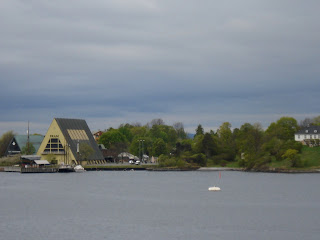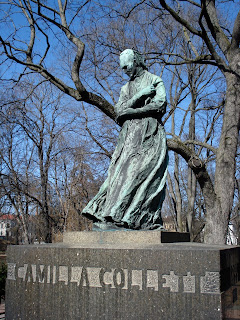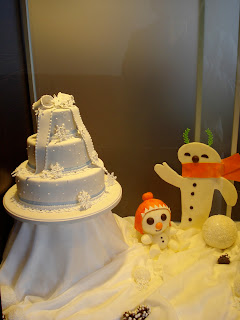Today, I finally felt like skiing was something I might actually be able to DO, sometime in the future.
We headed up to the Nordmarka at about 12.30. I rented my skis, sticks and boots with insurance from the Tryvann Vinterpark Skiservice for 210NOK. I think that this is relatively good value considering the risk to the ski hire business of having a Novice Ignoramous like me out and about using their equipment.
It hasn’t snowed in a week, so we weren’t sure if there was going to be enough snow to ski or not, but it turns out the conditions were perfect. I’m not sure what perfect conditions are, but the man in the ski hire shop said that, and after my experience, I believe him! It wasn’t overly sunny, and felt a little cold, but the air was so lovely and clean. It was great!
We went skiing at Kong Olav’s Lope, named after King Olav (1903 – 1991) who used to ski there often with his dog, Troll. Now, I don’t want to be casting aspersions on King Olav, or indeed his dog’s, skiing prowess, but we chose this place because of how relatively easy it is to ski. It has very little steep slopes or high ascents, and is perfect for a beginner like me.
The past couple of times I’ve been out I’ve literally frozen at the top of anything that looked like it was going downwards. (This happens a lot with mountains. ;)) But thanks to Henrik’s patience and repeated practice last week, I think I’ve actually developed a little.
For the first time (this is probably my fifth time skiing in total), I actually felt like I could go ‘downhill’. Now, when I say downhill, I don’t mean like a steep slope, I mean something with a gradient of about five degrees, going in a forward direction. But it was a brilliant feeling – leaning into the air while gliding forwards – not caring if I was going to fall or not, and gaining more and more confidence each time.
We spent about an hour and a half out on the mountain, practising technique, learning how to go downhill, learning how to break and stop, and falling a LOT! My boss at BAI told me that it takes 100 falls to make a skier. I think I’m getting pretty close to that target!
We found a nice spot at the top of the mountain to stop and have a picnic. Warm berry juice in a thermos and two brown bread sandwiches – one with paté and one with danish cheddar. Yum yum. After having eaten and rested, we skied a little more, and came home.
The Norwegians have a saying ‘Ut på tur, aldri sur’. It means, when your out in the fresh air, it’s never bad. I agree.

























































